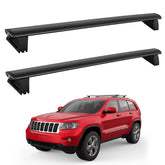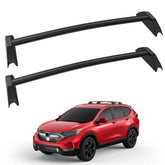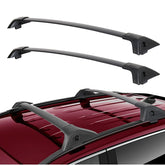Why are roof racks so expensive?
When you are preparing to move or go on a road trip, you will find that the trunk fills up quickly. To expand the luggage transportation capacity, many car owners will install a roof rack. Roof racks can transport various large items and make your journey more comfortable. However, roof racks, which seem to be simple metal frames installed on the top of the vehicle, have a high price. This confuses and surprises many first-time buyers. In this article, let's take a deep look at the price of roof racks, and installation costs, and understand why they are so expensive.

How much do roof racks cost?
Roof racks are popular for their obvious functionality, whether it's long trips, outdoor adventures, or daily hauling of items, they can bring extra storage space and convenience to your vehicle. However, when we dig deeper into these seemingly simple racks, we find that their prices range greatly, ranging from a few hundred dollars to thousands of dollars.
- Basic entry-level models start at around $100 to $150. These racks consist of simple crossbars and clips and are made of lightweight materials such as aluminum or plastic. They are suitable for light use, such as carrying smaller items such as suitcases or camping equipment, and they are not designed to withstand heavy loads.
- Mid-range racks range from $200 to $500 and have higher durability and additional features. Made of higher-grade aluminum or steel, these options have a more robust design and incorporate aerodynamic features to minimize noise and improve fuel efficiency. They are designed to accommodate heavier equipment and can support racks for bicycles, kayaks, or skis. These racks are suitable for frequent adventurers and outdoor sports enthusiasts.
- In the high-end category, prices can easily soar to over $600, with high-end models from brands like Thule or Yakima ranging from $700 to $1000. These racks are designed to be durable and sophisticated, using materials such as anodized aluminum, stainless steel, and reinforced composites to ensure long life even in extreme conditions. They are designed with advanced aerodynamic profiles to reduce drag, increase stability, and minimize noise.

How much to install a roof rack?
Installing a roof rack is more than just bolting a few crossbars to the top of your car. Depending on the complexity of the roof rack and the vehicle, installation costs can vary widely. Installation costs can range from a modest $50 to a staggering $500 or more.
- Simple Installation ($50-$100): For vehicles that already have roof rails or mounting points installed, installation is simple. Most auto repair shops or specialty stores can complete this installation for around $50 to $100.
- Intermediate Installation ($150-$300): For vehicles that don't have pre-installed mounting points, the cost increases. This requires additional hardware, such as mats, crossbars, or adapters to secure the rack to the roof. Repair shops will charge between $150 and $300 to cover the extra parts and labor required to make the rack stable and secure.
- Custom or Complex Installation ($300-$500+): Some vehicles, especially those with "bare" roofs (no rails or mounting points), require a custom installation. This involves drilling holes in the roof, aligning multiple pieces, and sealing for waterproofing. Professional installers will charge $300 to $500 or more for this complex work.
- High-end racks and dealer installation ($500+): For high-end brands or custom systems, those that integrate with your vehicle's electronics or require modifications, costs can exceed $500.
Finally, the cost of installing a roof rack ranges widely, with each layer of complexity adding to the final bill.
Why are roof racks so expensive?
Roof racks are more expensive than expected, and that comes down to a variety of factors to ensure they can handle transportation needs, withstand the elements, and mount securely to a variety of vehicles. Let’s break down why these seemingly simple add-ons cost so much.
Material quality and durability
Roof racks are designed to bear enormous weight while withstanding environmental conditions, which require durable materials such as aluminum, steel, and high-quality plastics. Many roof racks are also specially treated to ensure they are rust-proof, UV-resistant, and durable in extreme weather. This durability not only ensures longevity but also safety. High-quality materials such as corrosion-resistant aluminum and steel alloys increase durability, but they also increase costs.
Design and engineering costs
Each roof rack requires a custom design for different vehicle makes and models. This means manufacturers must invest time and money to design racks that can be securely mounted on different vehicles without damaging the roof. Modern roof racks even include aerodynamic features designed to reduce wind resistance and noise during driving. These small but critical details require a lot of engineering time, prototyping, and testing, all of which increase costs.
Brand premium
Many popular roof rack brands, such as Rhino-Rack, Thule, and Yakima, charge a premium for their products. This brand premium is partly because these companies invest heavily in research and development to create racks that stand out in functionality, safety, and style.

After-sales support and warranty
Many roof rack companies offer generous warranties and customer support. When purchasing an expensive roof rack, customers can expect to receive technical support, installation advice, and in some cases, replacement parts if problems arise. This customer service adds value.
Installation complexity
Roof racks need to be easy to install and very secure. This requires carefully designed mounting hardware to accommodate different roof shapes and types (bare roof, roof rails, etc.). High-quality mounting hardware is an additional cost that will increase the price.
How long do roof racks last?
Roof racks are the faithful companions of adventurers, city haulers, and family road trippers, and they're built to last. But how long do they last? Let's take a closer look at the lifespan of a roof rack. Generally speaking, a high-quality roof rack can last 10 to 20 years if properly cared for, and even longer under ideal conditions. Lower-end models, or those that are unmaintained and exposed to the elements, may only last 5 to 10 years. Rust spots, cracking, discolored or chalky surfaces, loose joints, or strange rattling noises are all red flags that your roof rack may be nearing the end of its useful life.
How to store roof rack?
Storing your roof rack may seem simple, but knowing how to take good care of it can extend its life and keep it in great condition. Whether you're planning on tucking it away for the winter or need more space in your garage, how you store your roof rack is important. Here are some tips for storing your roof rack:
Clean and inspect the rack
Before storage, give your roof rack a thorough clean. Over time, dust, road grime and salt can accumulate. Use mild soap and water, paying special attention to cracks and seams where dirt tends to accumulate. After cleaning, carefully inspect the rack for rust, worn straps or loose screws.
Choose an optimal storage location
Roof racks are made of durable materials such as aluminum or steel, which can be adversely affected by prolonged exposure to extreme temperatures or moisture. Try to store your rack in a dry, cool area away from direct sunlight. Some hobbyists prefer to use a garage or storage shed.
Invest in protective covers
If you're storing your roof rack for an extended time, consider covering it. A dust cover or specially designed roof rack bag will protect against dust, dirt, and accidental scratches. Choose a breathable material cover; non-breathable plastics can absorb moisture and cause rust or mold to form on the padding or any rubber parts. A breathable fabric cover allows air to circulate, reducing the risk of corrosion.

Disassemble for space efficiency
Some roof racks are modular, allowing you to remove certain parts. Removing crossbars, brackets, and other accessories not only saves space, but also reduces the risk of bending or stressing the parts. Make sure to store each part carefully and even label them for easier reassembly. Small hardware parts such as bolts and screws can be stored in labeled bags to avoid frustrating "where did they go?" moments.
Elevate off the ground
If you place your roof rack on the ground, use a pallet or sturdy wooden surface to elevate it slightly. This height helps avoid moisture on the ground. Also, keeping the roof rack elevated reduces the possibility of accidental knocks or incidents with other items in storage.
Featured Products
- $83.99
- $83.99
- Unit price
- / per
- $85.99
$138.90- $85.99
- Unit price
- / per
- $69.99
- $69.99
- Unit price
- / per
- $98.99
- $98.99
- Unit price
- / per














